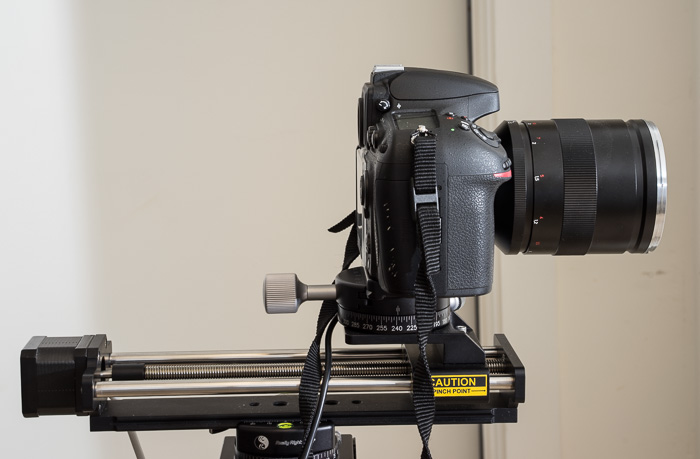I’ve been testing a Cognisys rail for stacked macros. Since I’ve been doing the shutter shock testing, I thought I’d see if the rail made things worse, and, if so, in what way.
I set up this gear: Zeiss 135mm f/2 APO Sonnar ZF.2 on a Nikon D800E, RRS D800 L-bracket, RRS clamp, Cognisys 200mm rail, Arca Swiss C1 Cube, RRS TVC-44 legs. Release in mirror up mode, with a programmed 5 second delay between mirror up and shutter tripping. ISO 100, lens set at f/5.6. ISO 12233 target with the camera at a distance to yield an active area about 700 pixels high. Thus, the lines labeled “7” represent 1 line pair per pixel pair.
I focused manually, wide open using the D800E’s most magnified live view setting. Live view on the D800E is as bad as live view on the a7R is good, but I’m pretty sure I got an accurate focus.
Target illumination for the continuous lighting images was provided by a single Fotodiox LED-200WA-56 lamp using the supplied reflector. Lighting for the strobe images came from a Paul Buff Einstein 640 watt-second flash set to 2.5 watt-seconds. At this power setting, the flash duration is about 1/13000 second. The camera was set to trailing curtain synch and the shutter to 3 seconds, allowing the camera to stabilize from the shock of the first curtain movement before the flash went off.
For the continuous-lighting pictures, the camera was set to 1/500 second with the Fotodiox at maximum output. An exposure was made. Then the shutter was set 1 stop slower, the light adjusted to give the same meter reading, and another exposure effected. That process was repeated all the way to a shutter speed of 1/4 second.
I used the 200 cm Cognisys rail, and tested it in three positions: with the carriage at the rear end (about half an inch from the stop), in the middle, and in the forward position, also about half an inch from the stop. The C1 clamped the rail in the center of the base. Thus in the rear position, the clamp was a little ahead of the center of mass of the camera/lens combination. In the middle position, the clamp was behind the center of mass, and is the forward position, the center of mass was well ahead of the clamp.
I processed the images in Lightroom with the default settings, corrected for (minor, as it turns out) exposure and white balance differences, and exported the files to Lightroom as layers. I labeled the layers with the exposure times and compared them. The images that I’m posting here are crops from the upper right-hand corner, enlarged 3x using nearest neighbor, and JPEG’d. Because of the way that Photoshop handles EXIF data from images composed of multiple layers, the EXIF data for the posted images is bogus. If anyone would like to see the Photoshop stack, please contact me.
In the all positions, there’s virtually no sharpness difference between the strobe-lit images and those at 1/500. Here’s what it looks like with the carriage in the rear position at 1/500:
With the carriage in the rear,
we start to lose a little in the vertical lines at 1/125, and in the horizontal lines at 1/30:
Things start to improve at 1/15, and by ¼, the image is almost as good as at 1/500:
With the carriage in the middle,
we start to lose a resolution at 1/125, and it doesn’t start getting back to excellent until 1/8. Here it is at 1/60, definitely impaired, but still acceptable for most purposes:
With the carriage forward,
1/125 is softer than in the other two positions, but it’s still sharp enough to show some false color:
1/60 is the worst with the carriage forward. The vertical lines are OK, but the horizontal ones are blurred as the rail acts a little like a diving board. 1/30 is hardly any better, and even 1/15 is soft for the horizontal lines:
1/8 is better, and ¼ isn’t bad, though not as good as ¼ for the other two positions:
Bottom line. Pretty good performance at the rear and mid positions, but try to keep shutter speeds at or faster than 1/250 or at or slower than 1/4 for best results.










Leave a Reply